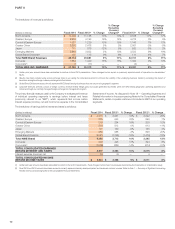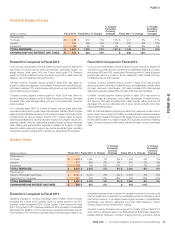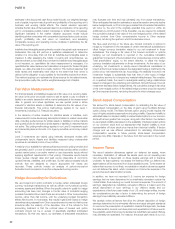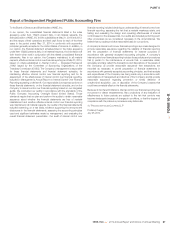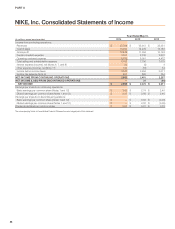Nike 2014 Annual Report Download - page 35
Download and view the complete annual report
Please find page 35 of the 2014 Nike annual report below. You can navigate through the pages in the report by either clicking on the pages listed below, or by using the keyword search tool below to find specific information within the annual report.
PART II
Translational exposures
Many of our foreign subsidiaries operate in functional currencies other than
the U.S. Dollar. Fluctuations in currency exchange rates create volatility in our
reported results as we are required to translate the balance sheets,
operational results, and cash flows of these subsidiaries into U.S. Dollars for
consolidated reporting. The translation of foreign subsidiaries’ non-U.S. Dollar
denominated balance sheets into U.S. Dollars for consolidated reporting
results in a cumulative translation adjustment to Other comprehensive income
within the Consolidated Statements of Shareholders’ Equity. In the translation
of our Consolidated Statements of Income, a weaker U.S. Dollar in relation to
foreign functional currencies benefits our consolidated earnings whereas a
stronger U.S. Dollar reduces our consolidated earnings. The impact of foreign
exchange rate fluctuations on the translation of our consolidated Revenues
was a detriment of approximately $288 million and $605 million for the years
ended May 31, 2014 and 2013, respectively. The impact of foreign exchange
rate fluctuations on the translation of our Income before income taxes was a
detriment of approximately $49 million and $104 million for the years ended
May 31, 2014 and 2013, respectively.
Managing translational exposures
To minimize the impact of translating foreign currency denominated revenues
and expenses into U.S. Dollars for consolidated reporting, certain foreign
subsidiaries use excess cash to purchase U.S. Dollar denominated available-
for-sale investments. The variable future cash flows associated with the
purchase and subsequent sale of these U.S. Dollar denominated securities at
non-U.S. Dollar functional currency subsidiaries creates a foreign currency
exposure that qualifies for hedge accounting under the accounting standards
for derivatives and hedging. We utilize forward contracts and/or options to
mitigate the variability of the forecasted future purchases and sales of these
U.S. Dollar investments. The combination of the purchase and sale of the
U.S. Dollar investment and the hedging instrument has the effect of partially
offsetting the year-over-year foreign currency translation impact on net
earnings in the period the investments are sold. Hedges of available-for-sale
investments are accounted for as cash flow hedges.
Refer to Note 6 — Fair Value Measurements and Note 17 — Risk
Management and Derivatives in the accompanying Notes to the Consolidated
Financial Statements for additional description of how the above financial
instruments are valued and recorded as well as the fair value of outstanding
derivatives at period end.
We estimate the combination of translation of foreign currency-denominated
profits from our international businesses and the year-over-year change in
foreign currency related gains and losses included in Other expense (income),
net had an unfavorable impact of approximately $139 million and $56 million
on our Income before income taxes for the years ended May 31, 2014 and
2013, respectively.
Net investments in foreign subsidiaries
We are also exposed to the impact of foreign exchange fluctuations on our
investments in wholly-owned foreign subsidiaries denominated in a currency
other than the U.S. Dollar, which could adversely impact the U.S. Dollar value
of these investments and therefore the value of future repatriated earnings.
We have hedged and may, in the future, hedge net investment positions in
certain foreign subsidiaries to mitigate the effects of foreign exchange
fluctuations on these net investments. In accordance with the accounting
standards for derivatives and hedging, the effective portion of the change in
fair value of the forward contracts designated as net investment hedges is
recorded in the cumulative translation adjustment component of
Accumulated other comprehensive income. Any ineffective portion is
immediately recognized in earnings as a component of Other expense
(income), net. The impact of ineffective hedges was immaterial for any period
presented. To minimize credit risk, we have structured these net investment
hedges to be generally less than six months in duration. Upon maturity, the
hedges are settled based on the current fair value of the forward contracts
with the realized gain or loss remaining in Other comprehensive income.
There were no outstanding net investment hedges as of May 31, 2014 and
2013. There were no cash flows from net investment hedge settlements for
the years ended May 31, 2014 and 2013.
Liquidity and Capital Resources
Cash Flow Activity
Cash provided by operations was $3,003 million for fiscal 2014 compared to
$2,968 million for fiscal 2013. Our primary source of operating cash flow for
fiscal 2014 was net income of $2,693 million. Our fiscal 2014 change in
working capital was a net cash outflow of $488 million as compared to a net
cash outflow of $78 million for fiscal 2013. Our investments in working capital
increased due to higher inventory levels to support higher reported futures
orders, growth in accounts receivable reflecting the increase in sales, and
higher prepaid marketing expenses in advance of the World Cup. These
increases in working capital were partially offset by increases in accounts
payable and accrued liabilities.
Cash used by investing activities was $1,207 million during fiscal 2014,
compared to a $940 million use of cash for fiscal 2013. A major driver of the
change was a $282 million increase in additions to property, plant and
equipment from $598 million in fiscal 2013 to $880 million in fiscal 2014,
reflective of investments in infrastructure to support current and future growth,
as well as digital capabilities. In fiscal 2014, we made $328 million in net
purchases of short-term investments (net of sales/maturities) compared to
$1,140 million in net purchases (net of sales/maturities) in fiscal 2013. Cash
used by investing activities in fiscal 2013 was partially offset by $786 million in
proceeds from the sale of Umbro and Cole Haan.
Cash used by financing activities was $2,914 million for fiscal 2014 compared
to $1,045 million for fiscal 2013, an increase of $1,869 million. The increase
was primarily due to a $954 million increase in share repurchases to $2,628
million, a $986 million decrease in net proceeds from long term debt issuance
(reflecting the issuance of 10- and 30-year notes in April 2013), and a $96
million increase in dividends, partially offset by a year-on-year increase in
proceeds from the exercise of stock options.
In fiscal 2014, we purchased 36.6 million shares of NIKE’s Class B Common
Stock for $2,628 million, an average price of $71.80. During fiscal 2013, we
completed the four-year, $5 billion share repurchase program approved by
our Board of Directors in September 2008. Under that program, we
purchased a total of 118.8 million shares at an average price of $42.08.
Subsequently, we began repurchases under a four-year, $8 billion program
approved by the Board in September 2012. As of the end of fiscal 2014, we
had repurchased 51.9 million shares at an average price of $65.83 for a total
cost of $3,417 million under this current program. We continue to expect
funding of share repurchases will come from operating cash flow, excess
cash, and/or debt. The timing and the amount of shares purchased will be
dictated by our capital needs and stock market conditions.
Capital Resources
On April 23, 2013, we filed a shelf registration statement (the “Shelf”) with the
SEC which permits us to issue an unlimited amount of debt securities. The
Shelf expires on April 23, 2016. On April 23, 2013, we issued $1.0 billion of
senior notes with tranches maturing in 2023 and 2043. The 2023 senior notes
were issued in an initial aggregate principal amount of $500 million at a 2.25%
fixed, annual interest rate and will mature on May 1, 2023. The 2043 senior
notes were issued in an initial aggregate principal amount of $500 million at a
3.625% fixed, annual interest rate and will mature on May 1, 2043. Interest on
the senior notes is payable semi-annually on May 1 and November 1 of each
year. The issuance resulted in gross proceeds before expenses of $998 million.
78




